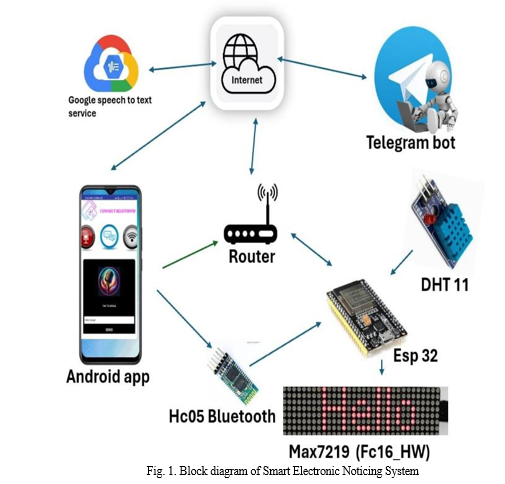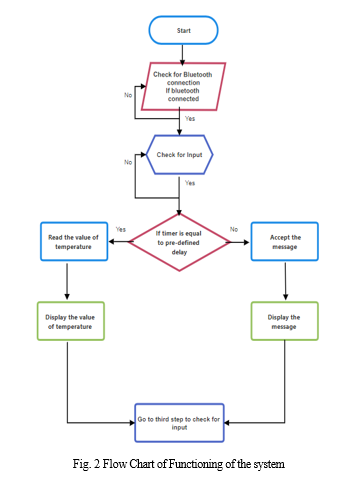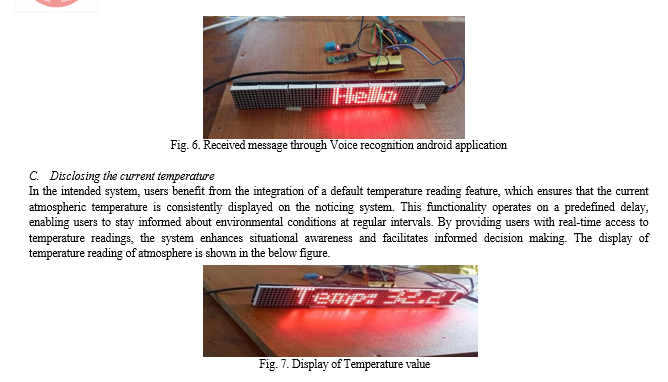Ijraset Journal For Research in Applied Science and Engineering Technology
- Home / Ijraset
- On This Page
- Abstract
- Introduction
- Conclusion
- References
- Copyright
Smart Electronic Noticing System Through Voice Alert and Text Message
Authors: Damodhar Rao Manda, Kommu Keerthi Srujana, Gudise Navya Sree, Nagulapati Navya Sri, Kokkiligadda Nikhil Sai Varma
DOI Link: https://doi.org/10.22214/ijraset.2024.59750
Certificate: View Certificate
Abstract
In the era of smart technologies, this project introduces an approach to streamline and enhance the process of electronic noticing by incorporating the voice commands and text messaging capabilities. The Smart Electronic Noticing System via voice and text message features reduces the reliance on traditional noticing system. This system is developed to offer an effective and user-friendly platform for managing announcements in various places such as shopping malls, traffic signals, hospitals, railway stations, bus stations, offices, and other public spaces. The system uses advanced voice recognition technology through android application to allow user to interact with the noticing system through spoken commands. Additionally, users can conveniently send notices via text messages with the help of telegram bot, further expanding the system\'s versatility. By the combination of voice command and text message features, the Smart Electronic Noticing System aims to redefine the way of user interact with and manage notices. Apart from the voice and text message capabilities, the system also has a capability to display the current atmospheric temperature with some pre- defined delay. This project aligns with the growing demand for accessible, and efficient smart solutions in today\'s technologically advanced world.
Introduction
I. INTRODUCTION
In an increasing technologically driven world, smart appliances are playing a vital role. The project aims to revolutionize the way of user who can manage the announcements through a noticing system in diverse environments. The aim of this prototype is to design a smart electronic noticing system that displays content originated by the user. The proposed system is capable to receive and showcase notices in the LED matrix display [1]. This proposed system exhibits several distinctive characteristics. The system offers the choice to send notices either through voice command or text message via a wireless network [9]. By integrating advanced voice recognition technology [4] and text messaging functionalities, the system aims to provide versatile interface for users to receive notifications seamlessly.
The core processing unit of the system is ESP32. The system is integrated with telegram bot for text messaging which uses wi-fi technology to make user more convenient from using GSM based electronic notice board [3]. Additionally, the voice recognition feature will be more advantageous in order to visualize the notice faster [8]. The noticing system is also capable of displaying the current temperature of environment with some predefined delay. The received notices will be displayed on a LED matrix display. This proposed system utilizes advanced technology and reduces the usage of manual noticing methods.
II. PROPOSED SYSTEM
The Smart Electronic Noticing System through Voice Commands and Text Message proposes a comprehensive solution for efficient communication and notice management. At its core, the system utilizes the ESP32 microcontroller as the central processing unit, enabling seamless integration of voice and text-based inputs. Through a voice recognition application, users can send voice messages to the ESP32, which in turn displays the messages on an LED matrix display. Additionally, the system interfaces with a Telegram bot, allowing users to send text messages that are also displayed on the LED matrix.
This dual functionality provides users with flexibility in communication methods, catering to individual preferences and situational needs. Furthermore, the system incorporates a temperature sensing feature, where the environment's temperature is displayed on the LED matrix every 30 minutes.

This real-time environmental monitoring capability adds value to the system, enhancing its utility in various contexts, from smart homes to industrial environments. Overall, the proposed system offers a versatile and user-friendly platform for efficient notice management and environmental monitoring, leveraging the capabilities of the ESP32 microcontroller to deliver a seamless and integrated experience. The block diagram of proposed system is represented in the below diagram.
A. Methodology
The methodology for the Smart Electronic Noticing System through Voice Commands and Text Messages involves a comprehensive approach encompassing hardware integration, software development, and the utilization of external platforms. The system consists of the components such as ESP32, Bluetooth HC-05 module for communication, DHT11 temperature sensor and LED matrix display for notice visualization. ESP32 module in the system serves as the core processing unit.
Implement the necessary connections to facilitate communication with other modules and sensors, ensuring compatibility with the chosen LED matrix display and temperature sensor. Set up and configure the Bluetooth HC-05 module to establish a wireless communication link between the ESP32 module and the Android device. Develop the necessary firmware to enable bidirectional communication for voice command input and notice display. Develop an Android application integrated with voice recognition capabilities. MIT app inventor is the software platform which is used to develop voice recognition application in order to accept the voice input. The speech inputs are transformed into text for the purpose of visualization on the noticing system. Ensure seamless integration with the Bluetooth HC-05 module for real-time communication with the ESP32 board.
Create a Telegram bot using the Telegram Bot API. Program the bot to receive notice messages and commands, and integrate it with the ESP32 through the internet. Develop a secure and efficient mechanism for sending text-based notices to the Smart Electronic Noticing System. Integrate temperature sensor with ESP32 that enables the electronic noticing system to showcase the current temperature reading of the environment.
Implement the logic to manage the LED matrix display according to received notifications. Develop functions to display text corresponding to the notices in a clear and visually appealing manner. Ensure synchronization with the ESP32’s central processing. Validate the accuracy of notice display on the LED matrix through both voice and text commands.
B. Hardware Specification
- ESP32 module: The ESP32 is a versatile microcontroller and Wi-Fi/Bluetooth module developed by Espressif Systems. It has built-in Wi- Fi and Bluetooth connectivity and widely used in Internet of Things (IoT) projects. It enables the system to accept voice commands from voice recognition application and text messages from the telegram bot.
- Bluetooth module: The purpose of Bluetooth module is short range wireless connectivity. This module will be paired with the ESP32. Bluetooth HC-05 module to establishes a wireless communication link with the ESP32 and voice recognition android application. ESP32 receives voice commands transmitted via Bluetooth, in order to enable user to control the noticing system using spoken instructions.
- Temperature sensor (DHT11): The DHT11 temperature and humidity sensor module widely used for monitoring environmental conditions in IoT applications. It consists of three-pin interface, consisting of power, ground, and a single-wire communication line. By integration of DHT11 sensor with ESP32 it facilitates the feature of displaying current temperature of environment through the LED matrix display.
- LED matrix display: The LED matrix display module is an electronic component that consists of an array of light-emitting diodes (LEDs) arranged in a matrix formation. This module is widely used to display the information which is received from the ESP32. These are of different sizes and with popular configurations like 8x8, 16x16, or even higher.
C. Software Specification
- Arduino IDE: The Arduino Integrated Development Environment (IDE) serves as a platform application that accommodates the programming languages C and C++. It enables the creation and uploading of programs to Arduino-compatible boards. In this project, it extends its support to the ESP32 module.
- Telegram bot: A Telegram bot is an interactive software application designed to operate within the Telegram messaging platform. The users can interact with electronic noticing system via text messages. Telegram bots can perform various tasks including sending notifications and managing user requests. This proposed system consists of the customized telegram bot from which a user can send text messages in order to display on the noticing system.
- Voice recognition android application: MIT App Inventor is a user-friendly software platform that is helpful for individuals, to create mobile applications for Android devices. The system needs a voice recognition android application which accepts voice commands from user and convert the instructions into text in order to display on the LED matrix display. The voice recognition application is developed using the platform MIT App Inventor. This application also has a flexibility to text message.
D. About Flow chart
Firstly, Initialize all the devices. After initialization, verify the status of the Bluetooth connection. If the Bluetooth connection is established, proceed to check for input from the system. If the Bluetooth is not connected then it waits for the connection. If the input is generated from telegram bot or voice recognition android application then the input message is displayed on the LED matrix display. The DHT11 sensor will read the temperature of environment according to the predefined delay and displays the value of temperature on the noticing system. After the visualization of temperature, the system will check for input. If the new message is generated, the system recognizes and displays the new message. The system will check for input and the above process will repeat. The implementation diagram of the proposed system is shown in the below flowchart.

III. RESULTS AND DISCUSSION
The Smart Electronic Noticing System represents a significant advancement in user-device interaction, seamlessly integrating voice commands and text notices through Android phones. By leveraging the ESP32 module, this system efficiently receives and converts notifications into text format, ensuring swift and accurate delivery to the user. Furthermore, its ability to dynamically display atmospheric temperature values enhances its utility and provides valuable real-time information. The system's adaptability to dynamic content changes ensures error-free communication, fulfilling its objectives with commendable efficiency. Through its innovative design and functionality, the Smart Electronic Noticing System sets a new standard for intuitive and responsive device communication, offering users a seamless and reliable experience.
A. Text message via Telegram bot
In the Proposed system, the Telegram bot serves as a text messaging channel for output messages. Leveraging the system's text messaging feature, users can seamlessly interact with the Telegram bot to generate and receive notices. This functionality ensures that important notifications and information are readily accessible to users in real-time. By harnessing the widespread accessibility and convenience of the Telegram platform, the system facilitates efficient communication and enables users to stay informed regardless of their location or device. The integration of the Telegram bot as the output mechanism underscores the project's commitment to providing a versatile and user-friendly solution for notice management, catering to the diverse communication preferences of users. The figure 3 shows the input text message which is sent through telegram bot and the display of received message via telegram bot is represented in the figure 4.


Conclusion
In conclusion, the Smart Electronic Noticing System, integrating voice command and text message functionalities, emerges as a highly efficient interface for visualizing notifications. By seamlessly incorporating advanced voice recognition technology alongside robust text messaging capabilities, the system ensures effective communication channels. Moreover, the integration of a temperature sensor adds further value by monitoring environmental conditions and providing real-time temperature data. With its versatile utility, this system holds immense potential across diverse applications, including but not limited to shopping malls, traffic signals, railway stations, hospitals, and bus stations, revolutionizing communication and spreading information in various public spaces. Its innovative features and adaptability make it a valuable asset in enhancing operational efficiency and user experience across numerous sectors.
References
[1] Md. Eftekhar Alam1, M.A Kader2, Shamima Akter Proma3, Sanchita Sharma4. Development of a Voice and SMS Controlled Dot Matrix Display Based Smart Noticing System with RF Transceiver and GSM Modem. International Conference of Computer and Information Technology (ICCIT)2018. [2] Mr. Ramchandra K. Gurav, Mr. Rohit Jagtap. Wireless digital notice board using GSM technology. International Research Journal of Engineering and Technology (IRJET). 2015; 02(09). [3] A. Meenachi, S. Kowsalya, P. Prem Kumar. Wireless E-Notice board using wi-fi and Bluetooth technology. Journal of Network Communications and Emerging Technologies (JNCET). 2016; 6(4). [4] VOICE CONTROL NOTICE BOARD. Sahoo, A., Kumari, S., Barman, S., Patra, S., & Panda, R. N. Dogo Rangsang Research Journal, UGC Care Group I Journal, Vol. 12, No. 5, May 2022, ISSN: 2347-7180. [5] Ms. Ekta1, Dr. Vivek Kumar2, Mr. Sandeep3 Design and Implementation of IoT based Smart Controlling Application for LED Scrolling Text Display with Integration of Google Assistant. International Research Journal of Engineering and Technology (IRJET)2020. [6] Voice Based E-Noticed Board Using Android, Gulhane, S.M., et al. IJRASET ISSN 2321-9653; IC Value: 45.98; SJ Impact Factor: 7.429 Volume Issue VII July 2021. [7] Dharmendra Kumar Sharma, Vineet Tiwari, Krishan Kumar, B. A. Botre, S.A. Akbar, “Small and Medium Range Wireless Electronic Notice Board using Bluetooth and ZigBee”, IEEE Indicon, 2015. [8] Ms. Snehal Laghe,” Voice based notice board”, International Engineering Research Journal (IERJ), Volume 2 [9] Neeraj Khera and Divya Shukla “Development of simple and low-cost Android based wireless notice board” IEEE 2016. [10] M. Arun, P. Monika and G. Lavanya “Raspberry Pi Controlled Smart e-Notice Board using Arduino” IJCAT 2017.
Copyright
Copyright © 2024 Damodhar Rao Manda, Kommu Keerthi Srujana, Gudise Navya Sree, Nagulapati Navya Sri, Kokkiligadda Nikhil Sai Varma. This is an open access article distributed under the Creative Commons Attribution License, which permits unrestricted use, distribution, and reproduction in any medium, provided the original work is properly cited.

Download Paper
Paper Id : IJRASET59750
Publish Date : 2024-04-02
ISSN : 2321-9653
Publisher Name : IJRASET
DOI Link : Click Here
 Submit Paper Online
Submit Paper Online

